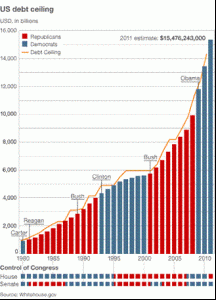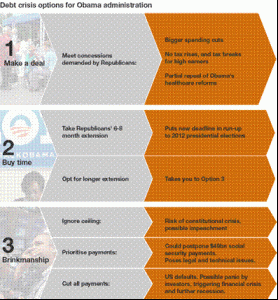The amount of debt the US is allowed to have is set by Congress (American Parliament) and so has to be decided by both the Republicans (Conservatives) and Democrats (Labour).
 In 2011 the US was coming up to its debt ceiling (the maximum amount of money the government is allowed to borrow), if Congress weren’t to agree for the ceiling to be raised then the US may have to default on its obligations (interest payments to debtors as well as payments to civil servants and social services etc).
In 2011 the US was coming up to its debt ceiling (the maximum amount of money the government is allowed to borrow), if Congress weren’t to agree for the ceiling to be raised then the US may have to default on its obligations (interest payments to debtors as well as payments to civil servants and social services etc).
We can see from the graph (source BBC News) to the left that in recent times all Presidents have increased the debt ceiling and borrowed money from international markets (particularly Chinese markets). However we can see that debt levels significantly increase under the leadership of Obama; mainly due to the financial crisis that led to his government introducing quantitative easing, and a fall in tax receipts.
The reason it can borrow a lot of money is because of its economic superiority and its credit rating of AAA (S&P) which is the highest possible (the UK also has this rating).
 Below is a list of possible actions that Obama could have taken (source BBC News). The government couldn’t raise the debt ceiling without votes from the Republicans, who opposed its rising as they believed America needed to get its debt levels under control. To do this they believed the government should reduce spending especially towards funding for its social reforms (such as free healthcare for the poor). The Democrats on the other hand believed that tax increases should be used to raise more money, but the Republicans heavily opposed this. The deadline for legislation was the 2nd August, but it didn’t look as if this would be met as meetings held with Obama (Democrat) and Republicans all failed. Finally on the 31st August an agreement was made where the Democrats agreed to cut spending over a 10 year period and the debt ceiling was raised on the day of the deadline!
Below is a list of possible actions that Obama could have taken (source BBC News). The government couldn’t raise the debt ceiling without votes from the Republicans, who opposed its rising as they believed America needed to get its debt levels under control. To do this they believed the government should reduce spending especially towards funding for its social reforms (such as free healthcare for the poor). The Democrats on the other hand believed that tax increases should be used to raise more money, but the Republicans heavily opposed this. The deadline for legislation was the 2nd August, but it didn’t look as if this would be met as meetings held with Obama (Democrat) and Republicans all failed. Finally on the 31st August an agreement was made where the Democrats agreed to cut spending over a 10 year period and the debt ceiling was raised on the day of the deadline!
It was agreed that $917 billion would be cut over 10 years in exchange for increasing the debt limit by $900 billion. The legislation also agreed that if $1.5 trillion is cut then further allowances would be made to raise the ceiling.
The US also lost its AAA rating by S&P, which might mean it finds difficulty borrowing money in the future or it may face increased interest rates. But due to its economic status as the world’s largest economy, this is unlikely.
Had the US defaulted, it is likely the world markets would have gone into turmoil and a double dip recession is possible. During the crisis billions was wiped off international stock markets as investors worried about what would happen if the US had defaulted.